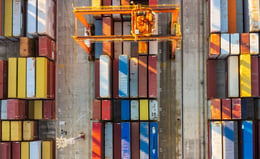The Most Common Kinds of Logistics Delays
Brian Hoey - July 14, 2020

Shipping volumes around the world are on the rise, and nearly 100% of consumers say that shipping times impact their loyalty to particular companies. While this stat reflects B2C trends more than anything else, B2B supply chain and logistics expectations are becoming more like B2C expectations every day, with corporate buyers expecting an Amazon-like experience wherever they go. Of course, this doesn’t change the reality that delayed shipments are a fact of life—and it doesn’t change how difficult it is to manage complex transport logistics processes in a smart, transparent way.
What it does change, however, is the urgency that logistics providers and other supply chain players are feeling when it comes to reducing disruptions and improving their rates of on-time delivery. In order to make those improvements happen, it’s important to know what kinds of delays you’re fighting against, and what tactics you can use to mitigate or avoid them.
1. Traffic and Weather Delays
Okay, so the most obvious issues with shipments of all kinds are very much out of the hands of the planners who have to deal with them. Large-scale weather events like hurricanes and tropical storms, or even smaller-scale events like heavy rain or wind, can quickly throw shipping routes into disarray. By the same token, accidents on the highway can cause backups that set your trucks’ timelines back by hours, potentially resulting in a domino effect of missed transfers and extremely late deliveries.
Though you can’t control traffic or weather patterns, you can control how you predict and respond to them. If you’re in the habit of relying on the same static, unchanging shipping routes for every logistics workflow, you’re probably not building much adaptability into your routes and tours. Though this will work out some of the time, when the unexpected happens you're often left high and dry, with no viable alternative to pivot to in case of a disruption. If, by contrast, for each new order you’re simulating different routes based on different parameters and predictions in order to choose the optimal fit, you can simply run a replanning whenever a disruption is predicted to hit. In this way, you become more proactive than reactive, and you minimize the impact even of catastrophic weather events that you can’t control.
2. Lost Shipments
The kind of replanning and analysis that we talked about above requires a high degree of visibility into your entire logistics chain—from carriers and 3PLs all the way down to the level of trucks and containers. In this way, you can use advanced analytics and digital twins to optimize your shipments on an ad hoc basis. This kind of visibility gives you the chance to get smarter and more responsive as you plan out your routes and tours, but it also gives you the ability to track shipments themselves more carefully—meaning that you can fight off our next cause of delay: lost orders. Simply put, there’s not much chance of getting something delivered to its end destination on time if you no longer know where it is—but with the introduction of things like IoT devices and RFID chips into the value stream (plus the supply chain management software solutions that let you track items based on those devices), you can keep tabs on each individual shipment more effectively.
3. Process and Tracking Errors
Related to the delay above, process errors can easily result in situations where you don’t know the location of a given shipment—or situations where a particular shipment is suddenly on the wrong container ship headed for a port on the other side of the world. Typically, this will be the result of simple human error, but the appropriate responses to errors like these are often anything but simple. In a case where a package is irrevocably lost, the simplest thing is just to start over and redo the entire order fulfillment process—but if you know where the package is and it’s headed in the wrong direction, you need to quickly figure out a way to get it back on track. This essentially requires you to combine the strategies we discussed in the previous two sections: rapid, real-time planning analyses that give you full visibility into different options based on specified parameters, and meticulous tracking using available technologies up and down the value chain. With these tactics in tow, you can gain rapid insights into your potential options for rectifying the errors. This might look like a quick backhaul to the nearest hub and then the consolidation of some existing shipments, or you might find that once the error has occurred the easiest thing is to restart order fulfillment on your end while working to reroute the original shipment to fulfill new and emerging orders. Whatever the solution turns out to be, your ability to leverage transparency and visibility up and down the supply chain will be the difference between successfully mitigating the delay and not.
IT Snafus
So far, we’ve mostly been discussing errors that might happen once a shipment has already left your inventory and is on its way to the recipient. But what if the delay isn’t caused by external factors or complications in logistics processes—what if, instead, your own supply chain management or logistics management solution was the root of the delay? This situation could arise because the left hand doesn’t know what the right is doing, so to speak—i.e. transport planners are trying to move resources that inventory management hasn’t provisioned for yet. Often, this is the result of planning and information silos that can crop up in environments that don’t have sufficient IT integration, or that might have Shadow IT deployments that aren’t connected to other related solutions throughout the supply chain. These sorts of silos create situations where otherwise reasonable-seeming plans simply don’t work out—resulting in shipments that weren’t sent at the right time, didn’t take the optimal route, or weren’t completed in full. Though this type of delay is slightly more abstract than the ones listed out above, it’s also the most crucial one to address within your IT environment. Why? Because addressing your IT infrastructure in this way enables you to tackle the other forms of delay listed above more effectively.
If you want to learn more get your Guide to Logistics 4.0
In this Guide you will learn:
-
Why a strategic process in transportation planning is a top priority for digitalization
-
What megatrends will increase supply chain volatility
-
How to manage it
LATEST POSTS
- Understand Circular Economy in The Manufacturing Industry
- How Can Industry 4.0 IT Integration Be Achieved Smoothly?
- The Significance of Order Sequencing in Discrete Manufacturing
- How to improve your Supply Chain Management: The Power of Control Towers
- Optimizing Human Resource Scheduling in Manufacturing: A Technological Approach



